Museum Eye
Published in 20th-century / Contemporary History, Issue 4 (Winter 2004), News, Volume 12The Irish Jewish Museum and Heritage Centre
3–4 Walworth Road, South Circular Road, Dublin 8
Oct.–April, Sunday, 10.30am–2.30pm
May–Sept., Sunday, Tuesday, Thursday, 11am–3.30pm
by Tony Canavan
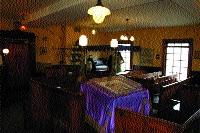
The synagogue upstairs—an impressive room, which houses a small display area that does not detract from the religious atmosphere engendered by the pews, the bema and the altar where the Torah was kept. (Irish Jewish Museum and Heritage Centre)
The Jewish minority has long been established in Ireland and there has been a recognisable Jewish community in Dublin since the eighteenth century. Its numbers were never great, and after the establishment of Israel in 1948 it began to decline rapidly. Before all was lost, a group of concerned Jews came together in the early 1980s with the intention of establishing a museum to preserve the history and heritage of their community for future generations. They acquired an apparently ordinary house on Walworth Road, which in fact had been a Jewish residence and contained a synagogue, and used it to house artefacts and documents from the Jews of Ireland. It was officially opened as a museum in June 1985 by President Chaim Herzog of Israel—from an Irish Jewish family himself—while on a state visit to Ireland. What those volunteers created is a museum of local, national and international significance.
The museum has not lost its character as a house and to visit it is like opening a box full of a family’s heirlooms, mementoes and photographs. It is an intimate, almost cosy, experience and the warm friendly welcome from the curator, Raphael Siev, adds to the homely atmosphere.
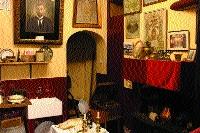
A unique insight into domestic life is provided by the carefully preserved kitchen. (Irish Jewish Museum and Heritage Centre)
The museum professional may shudder at the manner in which the artefacts are displayed. All kinds of items, from religious artefacts and books to photographs and banknotes, are vying for space in a series of numbered cabinets. That is not to say that the layout is haphazard. Each cabinet addresses a particular theme, such as public life, kosher food or youth groups, and all the items on display relate to the theme. Taken all together they present an intimate portrait of daily life for Ireland’s Jewish community since the 1880s, when most of them arrived here from the Russian empire following pogroms and the anti-Semitic May Laws. Birth, death, barmitzvahs, weddings, education and business are all covered. A unique insight into domestic life is the carefully preserved kitchen where, as the information panel reads, the ‘woman in the kitchen performed duties: cooking, baking, washing, mending; where she masterminded the development of the characters of her children and their interest and useful skills’.
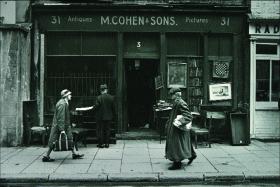
Cohen’s on Liffey Street in the 1940s. (Irish Jewish Museum and Heritage Centre)
The museum is eager to illustrate the Jewish community’s involvement in Irish society, with cabinets devoted to their contribution to the arts, for example in the work of writers like Leslie Daiken and Joseph Edelstein and artists such as Estella Solomons and Harry Kernoff. The remarkable Herzog family, which gave independent Ireland its first chief rabbi and Israel a president, has a cabinet devoted to itself. Many visitors will be surprised to discover the role of Jews in Famine relief in the 1840s, or that a Jew, Volunteer A. Weeks, died fighting in the Irish Citizen Army in the 1916 Rising, and that the Jewish community supported Irish independence, breaking away from the rabbinate of the United Kingdom to establish a new rabbinate for Ireland in 1922.
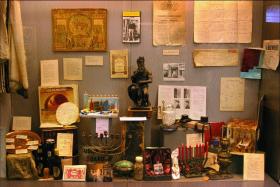
The Bloomsday display—the items may be crammed into the cabinets but they are all put there for a reason and relate to a particular theme. (Irish Jewish Museum and Heritage Centre)
The international aspect of the Jewish experience is reflected as well. There is a Jewish Irish diaspora in Israel, the United States and elsewhere, as the items on display from the Yiddish Sons of Erin in America, for example, illustrate. The museum has an archive which is often resorted to by Jews from abroad tracing their family tree. On the day I visited, one family from Liverpool and another from Canada were seeking information on grandparents who had emigrated from Dublin. Of course the Holocaust is addressed as well. It is included in a display on anti-Semitism in Ireland which makes for uncomfortable reading, as does the reminder that, whatever the Jews did to help the Irish during the Great Famine, the gesture was not returned by the Irish state during the Nazi persecution of Jews. One sad display is about Ettie Steinberg from Dublin, who was taken by the Nazis in France and so became the only Irish victim of the Holocaust. A simple yet poignant item in one cabinet is the crumpled and torn Torah scrolls that were rescued from a bonfire in Strasbourg during the Second World War.
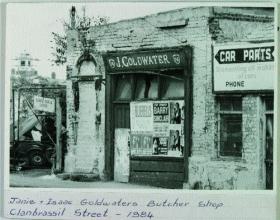
Janie and Isaac Goldwater’s butcher’s shop in 1984—evidence of the Jewish community’s decline. (Irish Jewish Museum and Heritage Centre)
These latter items are on view in the upstairs room which houses the synagogue. There were once many synagogues in the Portobello and surrounding areas. These were essentially private places of worship, accommodating from fifteen to 100 people. The opening of the larger communal synagogue at Dolphin’s Barn in 1926 led to the closure of the smaller ones, but fortunately the Walworth Road one survived and is the main reason for the museum being here. It is an impressive room, which houses a small display area that does not detract from the religious atmosphere engendered by the pews, the bema from where the rabbi conducted the service, and the altar where the Torah (the holy scripture) was kept. Plaques commemorating prominent members of the community hang on the walls, and beautiful embroidered silk ark-covers from the Adelaide Road synagogue occupy one corner.
This museum may never win any awards for design or technical excellence but it is a charming and enlightening place to visit. The items on display may be crammed into the cabinets but they are all put there for a reason and relate to a particular theme, whether that be the Jews in Joyce’s Ulysses or chief rabbis of Ireland. The story they relate is at once local, national and international, but at the same time intimate and engaging. The volunteers who established and run the museum have made the best use of the space available and have wisely not ‘over-interpreted’ the synagogue, which retains an atmosphere of serenity. It is a place well worth visiting, not just because it is of interest in itself as a museum but also because it recounts the history of one of Ireland’s most significant minorities.
Tony Canavan is a former Museum Officer of Newry and Mourne District Council.
















